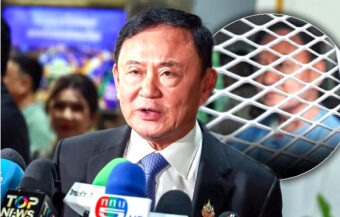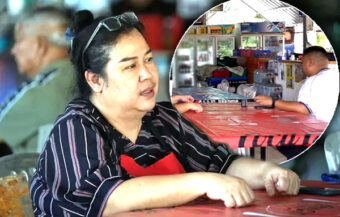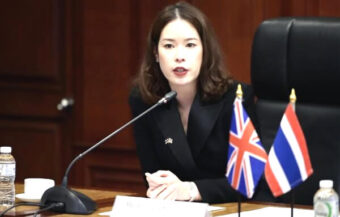Thailand braces for a year-end economic jolt as economists now target 2% GDP growth for 2025 despite collapsing tourism, Trump tariffs, Cambodia border clash and ongoing political turmoil with a bold ฿88-billion stimulus to revive domestic spending quickly.
Thailand is bracing for a stronger final quarter, with economists now eyeing GDP growth of 2% or more for 2025. Achieving this would be a rare bright spot in a year battered by collapsing foreign tourism, the Trump tariff shock, political turmoil, and a border clash with Cambodia. Driving optimism is a bold government ฿44 billion stimulus package, engineered to pump ฿88 billion directly into the domestic economy through a half-by-half co-payment scheme. The move is designed to reignite consumer spending fast and give the economy a vital jolt before year-end.

Thailand’s economy is bracing for a critical fourth quarter, as authorities roll out aggressive stimulus measures to jolt growth and fend off stagnation. The government, now under pressure from weak consumer demand and faltering exports, is banking on its new ฿88 billion “Khon La Khrueng Plus” scheme to provide the much-needed push.
The program is part of a larger economic rescue strategy as the country continues with low inflation, geopolitical tensions and climate-related disruptions.
The interim government, despite its limited mandate, has acted swiftly. On October 8, the cabinet approved the “Khon La Khrueng Plus” program, designed to increase household purchasing power. The scheme provides ฿2,400 in co-payment credit to each of the 20 million eligible tax-registered individuals. For every baht spent, the government pays half. This measure aims to inject ฿88 billion directly into the real economy by year-end.
Thailand’s Khon La Khrueng Plus scheme aims to inject 88 billion baht into the domestic economy this year
Finance Minister Ekniti Nitithanprapas, who also serves as deputy prime minister, called the scheme a “core engine” of Thailand’s fourth-quarter economic survival plan. He emphasised the urgency: “The country faces a serious risk of contraction. This scheme must work.” According to him, it will support small vendors, stimulate consumer demand, and modernise retail operations by integrating technology and training.
Notably, the scheme increases the daily subsidy from ฿150 to ฿200, expanding the scope of relief. For the first time, eligibility includes individuals aged 16 and above—reflecting the economic power of younger consumers, particularly in e-commerce. But participants must act quickly. They must register and make their first transaction by November 11 to remain eligible.
In parallel, the cabinet has approved a ฿23 billion top-up for 13.4 million state welfare cardholders. Each will receive ฿1,700 by year-end. Taken together, over ฿100 billion will be pumped into the economy through direct stimulus, expected to raise GDP by 0.3% to 0.4% in the final quarter. Officials hope these measures will double the current quarter’s modest projected growth of 0.3%.
UTCC raises GDP forecast to 2% despite risks from trade, floods, border conflict and tourism downturn
Meanwhile, the University of the Thai Chamber of Commerce (UTCC) raised its GDP outlook for 2025 from 1.7% to 2.0%, citing stronger-than-expected performance. The university pointed to key economic drivers: exports rose 15% in the first half, and private investment grew by 1.4% after years of stagnation. Accelerated imports from the U.S. helped push overall trade above projections.
However, risks abound. According to UTCC President Thanawat Phonwichai, multiple threats could derail growth. “We have more positive factors now, but the situation remains volatile,” he said. A protracted Thai-Cambodian border dispute has already triggered closures, disrupting trade valued at ฿59.1 billion. The GDP could take a 0.32% hit if borders remain shut through year-end.
Additionally, flooding continues across 36 provinces, affecting over 5.3 million rai of farmland. That’s an agricultural crisis unfolding in real time, with direct consequences for food supply, rural income, and inflation. These events compound concerns about the minority government’s stability, now in power just four months.
UTCC outlines worst-case and best-case scenarios for Thai GDP and tourism recovery this year
The UTCC ran several simulations. In a worst-case scenario, GDP growth this year could drop to just 1.2%. This would occur if Parliament dissolved early, the Thai-Cambodian border remains shut, the U.S. raises local content rules, and foreign tourists fall to 33 million. However, in a best-case scenario—where tourist arrivals rise to 34 million and political stability holds—GDP growth could reach 2.4%.
The tourism sector, once a pillar of the economy, remains sluggish. Although 16.7 million foreign tourists arrived in the first half of 2025, numbers are still 20% below pre-pandemic levels. Recovery has stalled. The government acknowledges that this soft rebound in tourism poses another drag on overall growth.
Moreover, the Monetary Policy Committee (MPC) has maintained its benchmark interest rate at 1.5% after a 5-2 vote. This was the first meeting chaired by new Bank of Thailand Governor Vitai Ratanakorn. While two members voted for a rate cut, the majority favoured caution. Exports have begun to weaken under U.S. tariffs. Domestic demand shows signs of strain. Yet inflation remains historically low, prompting fears of deflation.
Headline inflation declines for the sixth straight month while core prices remain steady and stable
Headline inflation dropped 0.72% year-on-year in September, marking the sixth straight monthly decline. However, the Commerce Ministry insists this is not a recession. “Core inflation is still rising. Employment is stable. Domestic demand is holding up,” said Nantapong Chiralerspong, director-general of the Trade Policy and Strategy Office.
Fresh food prices have fallen, and electricity tariffs have been cut for households to ease the cost-of-living burden. The government dropped power rates to ฿3.94 per kilowatt-hour, down from ฿3.98, covering September through December. These moves aim to protect low- and middle-income families.
However, this very deflationary pressure constrains monetary policy. The MPC noted that private credit is still contracting. Banks are cautious, especially in lending to SMEs and lower-income borrowers. The quality of loans among vulnerable groups continues to deteriorate. Some members argued for further rate cuts to ease the burden on small businesses and indebted households.
MPC projects growth of 2.2% in 2025 and outlines cautious outlook for next year amid global headwinds
According to MPC Secretary Sakkapop Panyanukul, the economy is expected to grow 2.2% in 2025 and 1.6% in 2026. The slowdown in the second half of 2025 is likely to be driven by U.S. tariffs, a soft tourism recovery, and subdued domestic consumption. Still, electronics exports may remain strong. Inflation is forecast to be 0.0% in 2025 and 0.5% in 2026, returning to the 1%-3% target range only by early 2027.
The baht, meanwhile, has seen sporadic appreciation, affecting exports. The MPC warned that exchange rate volatility should be closely monitored. Strengthening of the currency could undermine the fragile export sector and delay recovery.
As the year-end approaches, the government is determined to avoid an economic stall. It plans to roll out new stimulus measures every week, aiming for fourth-quarter GDP growth of at least 1%. This proactive strategy is essential as risks pile up—from global headwinds to local instability.
Still, observers caution that short-term stimulus may not fix deep-rooted problems. Structural reforms remain urgent. Thailand needs to modernise its industrial base, improve its digital infrastructure, and rebuild investor confidence amid political uncertainty.
Analysts warn short-term stimulus may be limited without structural reforms and political stability in 2026
While the “Khon La Khrueng Plus” and welfare top-ups are welcome, their impact may be short-lived. As Mr. Thanawat noted, “We must evaluate these schemes carefully. If they are effective, GDP can exceed 2%. But many variables remain.”
Indeed, if Parliament is dissolved ahead of schedule and early elections are called, political uncertainty could delay policy continuity. That risk weighs heavily on investor sentiment and business confidence.
Furthermore, if trade tensions between the U.S. and Asia escalate, Thailand’s export-driven economy will suffer. The transhipment tax debate adds another layer of complexity, with unresolved negotiations casting a shadow over logistics and supply chains.
In sum, Thailand faces a defining moment. Growth is possible—but fragile. Risks remain high. Policymakers must balance stimulus with structural change. They must also ensure stability in government, avoid geopolitical flare-ups, and restore confidence in the tourism sector.
Economy faced multiple shocks but retains unique resilience in inflation and domestic factors
Nevertheless, the economy has weathered a number of particularly negative developments this year. Firstly, there was the nosedive in foreign tourism from February. Secondly, the Trump tariff emergency, and of course, the outbreak of a border war with Cambodia. At the same time, a political crisis saw the government change for the third time in three years of political upheaval. It will likely change again in 2026 with a General Election in March/April 2026..
The fourth quarter will be a decisive test. If stimulus measures gain traction and external shocks are avoided, Thailand could post respectable growth. But if uncertainties persist, 2025 could end on a sobering note. Indeed, the Thai economy has a habit of disappointing in the last quarter of the year, with year-end growth often coming in against expectations.
Bank of Thailand boss stresses stability taking up the reins with a new man at the Ministry of Finance
Dark days ahead for the economy despite a 1.8% GDP gain with ominous warning signs on employment
The path ahead is narrow. Yet with targeted policy, quick deployment, and political resolve, Thailand still has a chance to turn in a year that keeps economic hopes alive.
Nevertheless, no one is in any doubt that what the economy ultimately needs is real, radical structural change. That will take a particular kind of government and bold leadership — neither of which is on Thailand’s agenda going into 2026.
Certainly, the country’s political instability has worsened this year, with most analysts now in agreement that Thailand’s economic woes are directly linked to its unstable politics. On the other hand, what is notable is the resilience of the economy and the country’s benign inflation environment, which are somewhat unique.
Join the Thai News forum, follow Thai Examiner on Facebook here
Receive all our stories as they come out on Telegram here
Follow Thai Examiner here
Further reading:
Dark days ahead for the economy despite a 1.8% GDP gain with ominous warning signs on employment
Concern for US tariff deal as new Thai government shows enthusiasm for stronger links with Beijing
Thailand’s once mighty tourism industry is failing but now faces further damage from overvalued baht
Rate cut anticipated as outgoing Bank of Thailand governor attends last Monetary Policy Committee


















